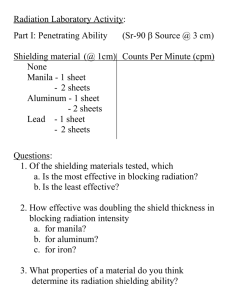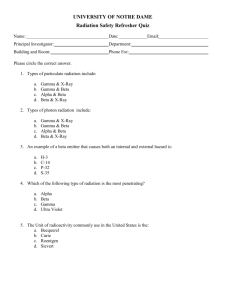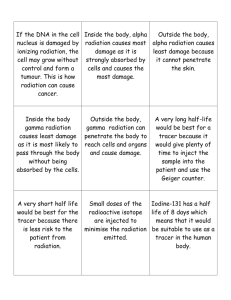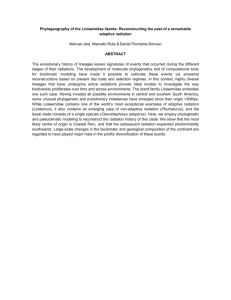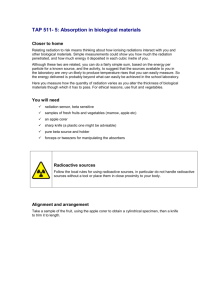Chapter 4 - Radiatio..
advertisement
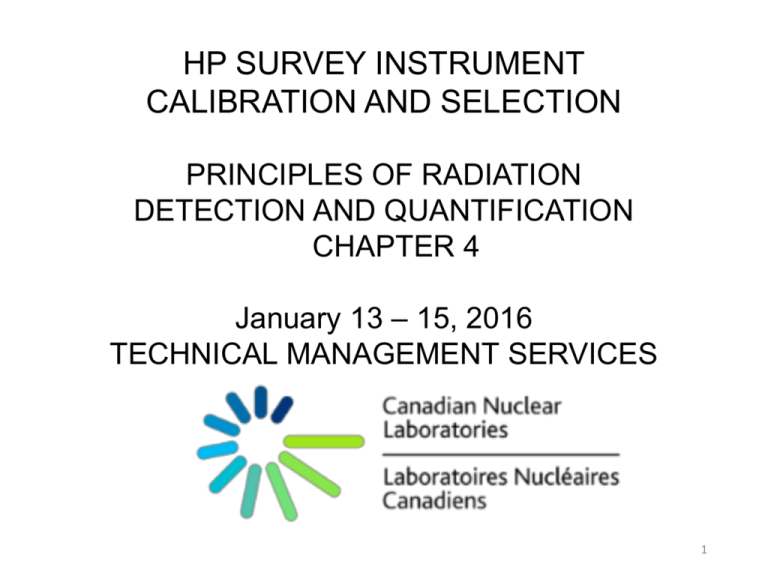
HP SURVEY INSTRUMENT CALIBRATION AND SELECTION PRINCIPLES OF RADIATION DETECTION AND QUANTIFICATION CHAPTER 4 January 13 – 15, 2016 TECHNICAL MANAGEMENT SERVICES 1 BACKGROUND RADIATION LEVELS AROUND THE WORLD Natural sources account for most of the radiation we all receive each year. The nuclear fuel cycle does not give rise to significant radiation exposure for members of the public, and even in two major nuclear accidents – Three Mile Island and Fukushima – exposure to radiation has caused no harm to the public. Radiation protection standards assume that any dose of radiation, no matter how small, involves a possible risk to human health. This deliberately conservative assumption is increasingly being questioned. 2 Radioactivity of some natural and other materials 1 adult human (65 Bq/kg) 4500 Bq 1 kg of coffee 1000 Bq 1 kg of brazil nuts 400 Bq 1 banana 15 Bq The air in a 100 sq metre Australian home (radon) Up to 3000 Bq The air in a 100 sq metre European homes (radon) Up to 30,000 Bq 1 household smoke detector (with americium) 30,000 Bq Radioisotope for medical diagnosis 7E7Bq Radioisotope source for medical therapy 100 TBq 1 luminous Exit sign (tritium) 1 TBq 3 Shielding Calculations The simplest method for determining the effectiveness of the shielding material is using the concepts of halfvalue layers (HVL) and tenth-value layers (TVL). One half-value layer is defined as the amount of shielding material required to reduce the radiation intensity to one-half of the unshielded value. HVL = ln 2/μ = 0.693/μ The symbol µ is known as the linear attenuation coefficient and is obtained from standard tables for various shielding materials. 4 5 The basic equation using HVLs is I = Io (1/2)n Where; I = shielded exposure rate Io = unshielded exposure rate n = # of HVLs = shield thickness (cm)/HVL thickness (cm) However, if the beam is broad, photons can be "randomized" and scattered into the area one is trying to shield. The secondary photons are accounted for by a build up factor, B, in the attenuation equation as follows: I = BI0e-ux where B is the buildup factor. 6 Tables of dose build-up factors can be found in the Radiological Health Handbook. The buildup is mostly due to scatter. Scattered radiation is present to some extent whenever an absorbing medium is in the path of radiation. The absorber then acts as a new source of radiation. Room walls, the floor, and other solid objects near enough to a source of radiation may make scatter appreciable. 7 When radiation scattering is a significant factor, the inverse square law may no longer be valid for computing radiation intensity at a distance. Measurement of the radiation is then necessary to determine the potential exposure at any point. – persons in the area behind a shield where there is no direct line of sight to the source are not necessarily protected. – a wall or partition is not necessarily a "safe" shield for persons on the other side. – radiation can be deflected around corners"; i.e., it can be scattered. 8 Shadow Shields ISO 4037 specifies the characteristics and production methods of x-ray and gamma-ray reference radiation for calibrating protection-level dosimeters and rate dosimeters. The standard limits scattered radiation to 5%. The shadow shield technique is a widely accepted test used to determine scatter contribution. Shadow shields are frequently used when calibrating photon survey instruments. Shadow cones are applicable to the calibration of neutron survey instruments. 9 Shielding a Detector From Interfering Radiations Alpha Shielding It takes very little shielding to absorb alpha radiation completely. A single sheet of writing paper will suffice for most alpha emitters. However, radon and thoron progeny present a challenge. To effectively shield the 8.78 MeV alpha from Po-212 the shield would somewhat attenuate low energy beta emitters. Pulse height discrimination is another method of minimizing alpha interference. 10 Shielding a Detector From Interfering Radiations Beta Shielding It takes very little shielding to absorb beta radiation completely. However, bremsstrahlung production is enhanced by high Z materials, for effective shielding of beta particles one would use a low Z material, such as plastic. This would allow the Beta particle to lose its energy with minimal Bremsstrahlung production. A material suitable to shield the Bremsstrahlung X-rays (such as lead) would then be placed on the "downstream" side of the plastic. In practice a photon detector may have a simple low Z shield to remove interference from beta radiation. 11 Shielding a Detector From Interfering Radiations Photon Shielding Shielding an alpha or beta detector from photon interference is best done with either pulse height discrimination or pulse shape discrimination. Neutron detectors may be shielded from photon interference through a combination of HV adjustment and pulse height discrimination. 12 Shielding a Detector From Interfering Radiations Neutron Shielding Neutron radiation is very often found with a photon radiation field. For many alpha detectors based on ZnS or semiconductors minimizing any neutron target material near the detector can be effective. Any photon component may be minimized with pulse height discrimination. Most photon ion chambers and gas proportional and GM detectors will respond to fast neutrons. An NaI(Tl) or other similar gamma detector will have very little direct response to neutrons. 13 14 Ludlum 44-40 Alpha/Beta/Gamma 15 DETECTOR: pancake-type, halogen quenched GM WINDOW: 1.7 + 0.3 mg/cm² mica with stainless steel protective screen WINDOW AREA: 15.51 cm² (2.4 in²) active, 12.26 cm² (1.9 in²) open EFFICIENCY (4π): 5% for 14C; 22% for 90Sr/90Y; 19% for 99Tc; 32% for 32P; 15% for 239Pu SENSITIVITY (137Cs gamma): 3300 cpm/mR/hr BACKGROUND: 25 cpm GAMMA FRONT TO BACK RATIO: 4 to 1 LEAD SHIELD THICKNESS: 1.3 cm (0.50 in.) SIZE: 11.4 x 10.2 x 16.5 cm (4.5 x 4 x 6.5 in.) (H x W x L) WEIGHT: 2.5 kg (5.5 lb) 16 17 18 Ludlum 44-38 beta, gamma survey 19 DETECTOR: 30-45 mg/cm² stainless steel wall halogen quenched GM DETECTION RANGE: ±10% up to 500mR/hr with DTC SENSITIVITY: 1200 cpm per mR/hr (137Cs gamma) with window closed BACKGROUND: 20 cpm closed; 25 cpm open GAMMA ENERGY RESPONSE: response within 20% of 137Cs (662 keV) from 60 keV to 1.3 MeV BETA CUT OFF: approximately 200 keV (window open) WINDOW CONSTRUCTION: Low Energy Blocking Shield: tin shields mounted on aluminum (1353 mg/cm²) with solid aluminum gap in the middle Low Energy Pass Through Window: solid aluminum (610 mg/cm²) 20 ALMOST EVERY TYPE OF RADIATION DETECTOR RESPONDS TO ALMOST EVERY TYPE OF RADIATION IF you don’t know which radionuclides are in the survey area you need to determine which radionuclides are present in order to quantify them. 21 End of Chapter 4 Questions ? Comments ? 22
